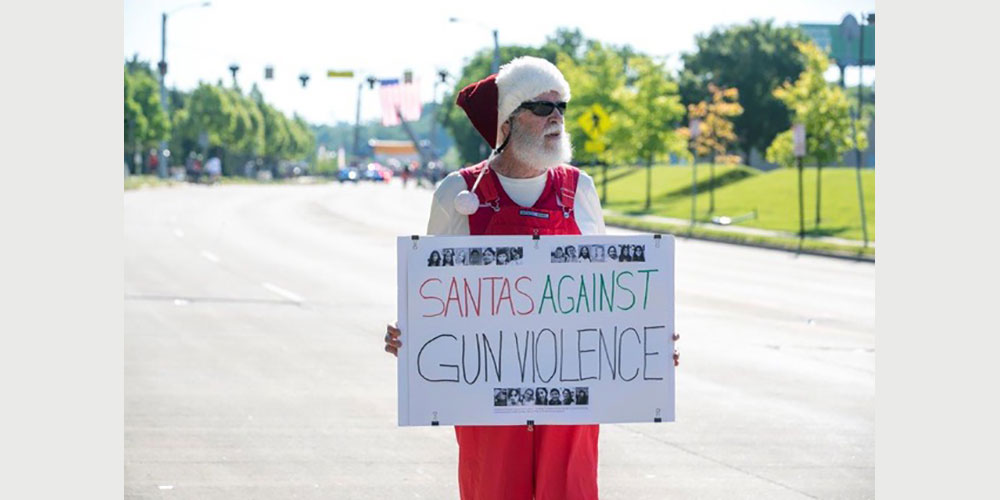Note: The views expressed by guest bloggers and contributors are those of the authors and do not necessarily represent the views of, and should not be attributed to, Campus Safety.
My name is Art Hoffman. I’ve had over 50 years as a public health professional, addressing a myriad of public health issues. Gun violence is one of them.
My other hat is red and has a white pom-pom on it. “Santa Art” also has a 50-year “career.” It centers upon bringing joy to kids and families throughout our country and according to legend, almost 200 other nations. My mission is to look out for the welfare and safety of children everywhere.
Perhaps because I visit all countries during a very long shift on Christmas Eve, I confront an inescapable reality. We know that mass shootings in the United States occur more frequently than any other country. We also know that since 1970, there have been over 2,000 school shootings in America. The group “Every Town for Gun Safety” reports that, tragically, there have been about 1,000 incidents of gunfire at schools and colleges since Sandy Hook. These figures for mass shootings and school shootings vastly outnumber the corresponding categories for other countries.
Each year, thousands of individuals “get a grip” on a gun and wreak this sort of havoc. Often the target is school children. Earlier this year, we discovered the shooter was a child himself. Yet many discussions and solutions, though well intended, have largely proven unsuccessful. America is plagued by gun violence. Many causative factors exist. Throughout this article, I will offer the perspectives of one individual, uniquely situated with a foot in two different worlds: public health and Santa Claus.

It was gratifying to learn that in Jan. 2023, in Frankfort, Kentucky, students themselves were approached for solutions, identifying ways in which schools can improve their security. This is a novel approach indeed, since too often student feedback is lacking. Commissioner’s Student Advisory Council outlined strategies to adopt before, during, and after school shootings. “Before” included a tip line to report worrisome behavior among students, follow-up, and a desire for stronger gun control legislation. “During” took a look at the active shooter drills, better training for first responders, and notification systems for both parents and students. “After” included necessary mental health support, community support, and acknowledging that not only the school’s physical damage, but the emotional impact on traumatized students and staff, need to be considered. Readers can contact the commission to learn more and stay abreast of their thoughtful and comprehensive approach.
As reported in the Washington Post on Jan. 13, while commemorating Martin Luther King Jr. Day, columnist Colbert King referenced the easy access to guns. Poignantly, he criticized “faith leaders, seemingly on mute.” That was profound and personal to me. Santa Claus is in part a faith leader, dating back about 1,700 years to Saint Nicholas of Myra. Why, then, do so few Santas today even want to discuss the dangers our kids face each day as they set off for school? Why aren’t all Santas speaking out against gun violence? Certainly, none of them can be for it. I have my theories, and undoubtedly you have yours. But it’s time to “get a grip” on this elephant in the room.
In my career, I’ve worked with epidemiologists. They are less concerned with applying Band-Aids on diseases and more invested in seeking out the root causes. Unquestionably, in America, one of the root causes is there are about 400 million guns in a country of 330 million. As others have pointed out, many of these guns are “weapons of war” yet are owned by civilians. On Jan. 24, California Governor Gavin Newsom opined after the two mass shootings in California that the “Second Amendment is becoming a suicide pact.” It is difficult to argue with that logic.
Ironically, the mass shooter in Lewiston, Maine, committed suicide. We learned just days later that three-term Congressman Jared Golden reversed his stance on assault rifles. He now wants them banned (admirable and in defiance of NRA policy) but his rationale was stunning. He did not think that such a shooting in his rural community would occur. Never one thought along those lines amidst all the thoughts and prayers conveyed after each mass shooting? He “stuck to his guns” despite decades of gun violence in virtually every part of every state in America. It would have been more impactful if he could have been the kind of leader described many years ago by Rosalynn Carter: “A leader takes people where they want to go, a great leader takes people where they do not necessarily want to go, but where they ought to be.”
Over thirty years ago, I saw a photo of a boy walking to school wearing a bulletproof backpack. I was dumbfounded at the time since everything about the article and photo presented that as plausible and normal. It seemed that most Americans felt no shock or outrage at that image. But it was certainly a harbinger of things to come. Today, the Internet is full of ads for such products. We have become sufficiently numb that this seems to be a sensible approach now.
What about the outcry over the six-year-old who shot his teacher? Officials evidently were ill-equipped and unprepared according to reports, quoting some as saying, “We’ve had nine and eight and seven-year-olds in the past wielding guns, but never a six-year-old.” Why weren’t barely-older kids a cause for alarm just as much as the younger one is now? The evolution to younger kids was entirely predictable as the four-year-old in Indiana demonstrated a few weeks later.
Why is America so reluctant (afraid?) to examine the root causes of gun violence? Why can’t we “get a grip” on what needs to be explored? After each shooting, it’s always the same: “What’s the motive?” Here’s where the focus should be instead. Since about 98% of the shooters are male, something I have been pointing out for decades, strategies need to be developed to target the ways in which boys are being raised. It was not a young girl who climbed up on my lap a few years ago and claimed, “Santa, I just shot all your Reindeer.” It wasn’t a middle school girl who interjected, “I just shot her” during my taking attendance in a sixth-grade class when I asked why a certain student was absent. And, while I get some requests for the famous Red Ryder BB gun from girls, care to guess the overwhelming gender?
Clearly, it would be worthwhile, almost essential, to address the ways our boys and young men are raised. Forty years ago, I incorporated a valuable model in my workshops that addresses men’s wellness and behavior. It listed six societal expectations for males. Three, in particular, are relevant to this crisis: the traditional masculine role “Give them Hell“ (aggression), “The Sturdy Oak,” (I can solve all problems), and “The Big Wheel,” (I have to be the best in everything). Readers can contact me directly for a more complete analysis of this model.
In summary, I am more convinced than ever that what is needed is a holistic, epidemiological, and political strategy. Piecemeal interventions offer some help. Red flag laws, gun locks, and metal detectors all have a role but continuing the easy access to guns throughout the country in the hands of boys and young men must be addressed. My discussion here is designed to challenge readers to think more broadly along those lines. Professionals need to “get a grip” so that schools and campuses — and society at large — are haunted less by thousands of hands on thousands of grips.
Art Hoffman began his public health career in the 1970s with Planned Parenthood before becoming executive director of Safer New Mexico, a social services organization charged with educating the public about seatbelts, child passenger safety, and DUI issues. He was also involved in smoking prevention and cessation programs while helping to secure a Clean Indoor Act for the state. Art also provided AIDS education and training for doctors, nurses, counselors, and teachers.
In the 1990s, Art provided physical education classes at a local Catholic school, and pursued various other educational activities such as ESL, adult education programs with the Louisville jail and corrections departments, and assisted with a horse therapy program for disabled children and adults. He officially retired 15 years ago but has remained involved with public health programs in Louisville. During the pandemic, Art devoted a considerable amount of time educating the public on the emerging crisis, capitalizing on his status as Santa Claus.







